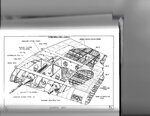Admiral Beez
Major
Interesting note about concern over the added weight of a folding wing mechanism.
"The provision of a folding wing was examined in 1940. But the desperate need for aircraft designers for next-generation aircraft, as well as concerns over the Hurricane's ability to accommodate the extra weight, soon saw this idea abandoned. " http://www.armouredcarriers.com/hawker-sea-hurricane-variants
I didn't think the Hurricane was considered nearly overweight in standard spec. Did the Seafire or Wildcat gain a lot when the fold was added?
Seafire
Seafire Mk IIc with 36 ft 10 in wingspan, 2x20mm 4x.303, and Merlin 46. Empty weight 5,300 lb (2,404 kg)
Seafire Mk. III with folding wings, 32 ft 2 in wingspan, and Merlin 55M. Empty weight: 5,450 lb (2,472 kg)
By shortening the wingspan, the weight between the two Seafires goes up by only 150 lbs. IDK how much of this 150 lb. increase is due to the engine upgrade.
Would the Sea Hurricane really have become overweight if folding wings were added? Mind you, the Hurricane IIc weighs 5,745 lb (2,606 kg) empty - by the time the Seafire got near that empty weight it was Griffon-powered.
"The provision of a folding wing was examined in 1940. But the desperate need for aircraft designers for next-generation aircraft, as well as concerns over the Hurricane's ability to accommodate the extra weight, soon saw this idea abandoned. " http://www.armouredcarriers.com/hawker-sea-hurricane-variants
I didn't think the Hurricane was considered nearly overweight in standard spec. Did the Seafire or Wildcat gain a lot when the fold was added?
Seafire
Seafire Mk IIc with 36 ft 10 in wingspan, 2x20mm 4x.303, and Merlin 46. Empty weight 5,300 lb (2,404 kg)
Seafire Mk. III with folding wings, 32 ft 2 in wingspan, and Merlin 55M. Empty weight: 5,450 lb (2,472 kg)
By shortening the wingspan, the weight between the two Seafires goes up by only 150 lbs. IDK how much of this 150 lb. increase is due to the engine upgrade.
Would the Sea Hurricane really have become overweight if folding wings were added? Mind you, the Hurricane IIc weighs 5,745 lb (2,606 kg) empty - by the time the Seafire got near that empty weight it was Griffon-powered.

